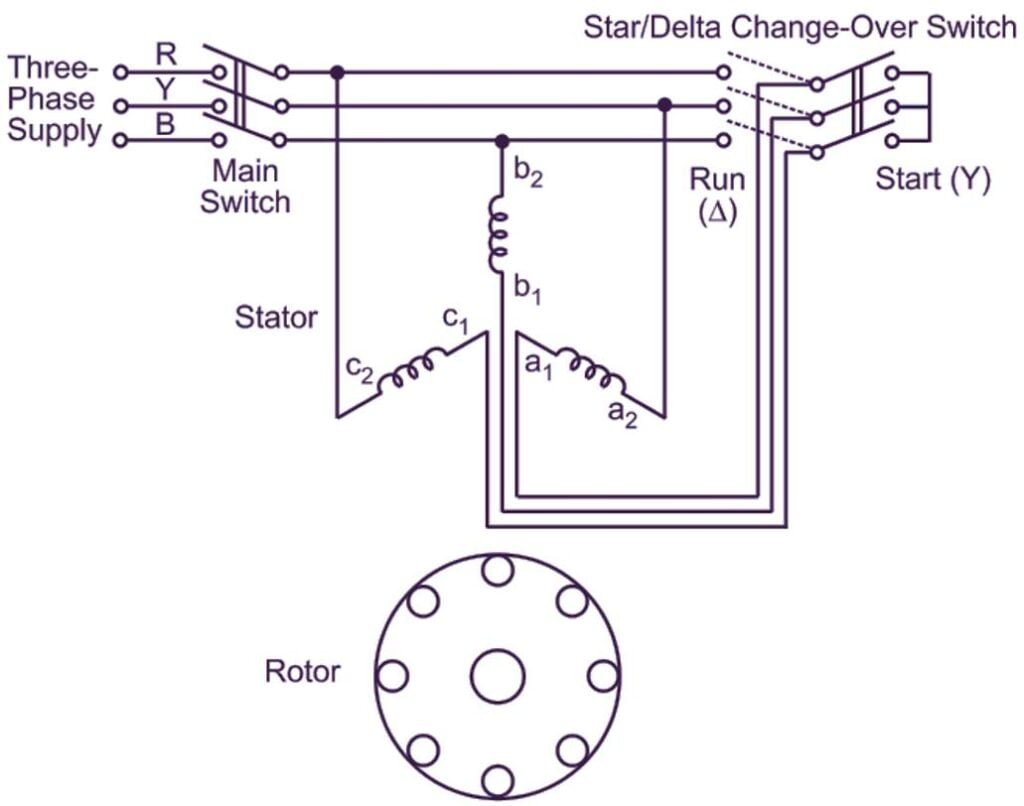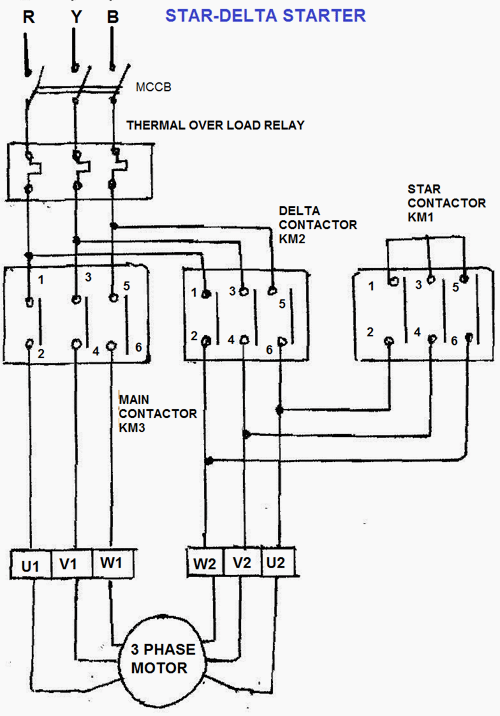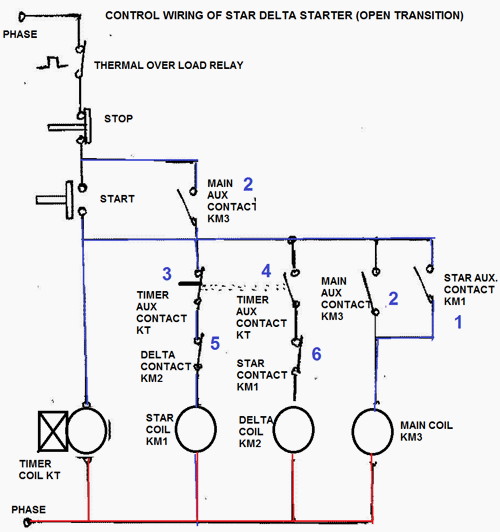What is Star Delta Starter
A Star Delta Starter, also known as a Wye Delta Starter, is an electrical device or method used to control and start three-phase induction motors. Its primary purpose is to reduce the inrush current, or the initial surge of current when a motor is started, which can be very high in magnitude and potentially harmful to the motor, the electrical system, and other connected equipment.
The Star Delta Starter achieves this reduction in current by initially connecting the motor windings in a star (Y) configuration during startup. This configuration reduces the voltage applied to each winding, resulting in a lower current draw. Once the motor has reached a certain speed, typically around 70-80% of its full speed, the starter switches the windings to a delta (Δ) configuration, which connects them in a way that allows the motor to operate at its full rated voltage and torque.
In summary, a Star Delta Starter is an essential component in motor control systems, particularly for large three-phase induction motors, as it helps protect the motor and the electrical system from the adverse effects of high inrush current while ensuring a smooth and controlled motor startup.

application of star delta starter
A star delta starter is well-suited for applications where minimizing the starting current and maintaining a stable line current draw are critical. It excels in scenarios where the required starting current is relatively low, effectively reducing inrush current and preventing voltage drops during motor startup. However, it may not be the best choice for applications demanding high starting torque, as it provides reduced torque during the initial star configuration.
In cases where the motor is heavily loaded, there may not be sufficient torque to accelerate it to full speed before transitioning to the delta configuration, potentially affecting performance. An example application that often benefits from a star delta starter is a centrifugal compressor, where the load during startup tends to be lower, aligning with the starter’s ability to minimize current surges. It’s crucial to assess the specific motor and application requirements to determine whether a star delta starter or an alternative motor starting method is most appropriate.
A Star Delta Starter is an electrical control device used in industrial and commercial applications to control the starting of three-phase induction motors. It is primarily employed in situations where the motor’s initial high inrush current during startup needs to be reduced to minimize stress on the electrical system and the motor itself. Here are some common applications of Star Delta Starters:
- Industrial Pumping Systems: Star Delta Starters are frequently used in water pumping stations and other fluid-handling systems. They help reduce the current surge when starting a large pump motor, preventing electrical disturbances and mechanical wear and tear.
- Conveyor Systems: Conveyor belts in manufacturing and distribution facilities often use three-phase induction motors. Star Delta Starters are used to start and stop these motors smoothly to avoid jerky motion and excessive current draw.
- Air Compressors: In facilities where compressed air is needed for various applications, Star Delta Starters are used to control the starting of air compressor motors. This ensures a gradual ramp-up of motor speed and reduces the strain on the electrical grid.
- Mining Equipment: Heavy machinery in mining operations often relies on large three-phase motors. Star Delta Starters are employed to minimize the current spike when starting these motors, which can be beneficial in remote mining locations with limited power supply capabilities.
- HVAC Systems: Heating, Ventilation, and Air Conditioning (HVAC) systems in large commercial buildings may use Star Delta Starters to manage the starting current of the motors in air handling units and chillers.
- Material Handling Equipment: Equipment like cranes, hoists, and winches, which require precise control of motor starting and stopping, can benefit from the use of Star Delta Starters to reduce mechanical stress and maintain system stability.
- Agitators and Mixers: In chemical and food processing industries, where agitators and mixers are used, Star Delta Starters can provide a controlled and smooth start to avoid splashing or damaging the contents.
- Irrigation Systems: Large agricultural irrigation pumps often use three-phase motors. Star Delta Starters can prevent voltage sags and other electrical issues that can affect the overall performance of the irrigation system.
- Oil and Gas Industry: Many applications in the oil and gas sector, such as pumps, compressors, and drilling equipment, rely on Star Delta Starters to manage motor startup and reduce the impact on the power grid.
- Wastewater Treatment Plants: These facilities use various pumps and motors for the treatment process. Star Delta Starters help manage the starting current of these motors, ensuring efficient and reliable operation.
In all these applications, the primary goal of using a Star Delta Starter is to reduce the initial high current demand of the motor during startup, which can cause voltage drops, affect other equipment on the same electrical system, and lead to mechanical stress and premature motor failure. The transition from star to delta configuration provides a controlled and smoother start for the motor, improving overall system reliability and efficiency.

advantages of star delta starter
Star Delta Starters offer several advantages in the control and protection of three-phase induction motors, particularly in industrial applications. Here are some of the key advantages of using Star Delta Starters:
- Reduced Inrush Current: One of the primary benefits of using a Star Delta Starter is the significant reduction in inrush current during motor startup. When a motor is started in the star configuration, the line current is approximately 1/√3 (about 58%) of the current when the motor is started in the delta configuration. This reduces stress on the electrical system and prevents voltage sags or dips that can occur with high inrush current.
- Mechanical Stress Reduction: High inrush current during direct-on-line (DOL) starting can cause mechanical stress on the motor’s shaft, bearings, and connected equipment. Star Delta Starting reduces this stress, resulting in smoother and gentler motor acceleration.
- Energy Efficiency: Star Delta Starters help improve energy efficiency by limiting the initial current surge. This can result in lower electricity costs, especially in applications where motors are frequently started and stopped.
- Extended Motor Life: Reduced mechanical and electrical stress on the motor leads to an extended motor life. Motors started with Star Delta Starters tend to have a longer operational lifespan compared to those subjected to direct-on-line starting.
- Improved Voltage Stability: The controlled transition from star to delta configuration helps maintain stable voltage levels in the electrical system, reducing the likelihood of voltage fluctuations and associated problems like flickering lights and equipment malfunctions.
- Compliance with Grid Regulations: Some electrical grids or utilities impose restrictions on the maximum allowable inrush current. Using Star Delta Starters allows businesses to comply with these regulations and avoid penalties.
- Smooth Acceleration: Star Delta Starters provide a smooth and gradual acceleration of the motor, reducing the risk of sudden torque spikes and mechanical shocks to connected equipment.
- Enhanced Motor Control: The ability to start a motor in the star configuration and then switch to delta allows for finer control over motor speed and torque, making it suitable for applications with specific performance requirements.
- Reduced Thermal Stress: The reduced inrush current leads to lower thermal stress in the motor windings, resulting in less heating and improved thermal performance.
- Compatibility with High-Power Motors: Star Delta Starters are particularly useful for high-power motors where the inrush current can be extremely high. Using this starting method ensures safer and more reliable motor operation.
- Lower Starting Torque: In some cases, such as when starting a conveyor or pump, the reduced starting torque in the star configuration can be an advantage, preventing sudden jerky movements.
- Ease of Maintenance: Star Delta Starters are relatively simple in design and are easy to maintain and troubleshoot, reducing downtime and maintenance costs.
While Star Delta Starters offer numerous advantages, it’s important to note that they are most effective in applications where a gradual start is acceptable. In cases where rapid acceleration is required, other starting methods like soft starters or variable frequency drives (VFDs) may be more suitable.

disadvantages of Star Delta starter
While Star Delta Starters offer several advantages, they also come with certain disadvantages and limitations that need to be considered when choosing the appropriate motor starting method. Here are some of the disadvantages of using a Star Delta Starter:
- Limited to Induction Motors: Star Delta Starters are primarily designed for three-phase induction motors. They may not be suitable for other types of motors, such as synchronous motors or motors with special starting requirements.
- Reduced Starting Torque: During the star (Y) configuration, the motor receives reduced voltage, which can result in lower starting torque compared to direct-on-line (DOL) starting. This limitation can be problematic for applications requiring high initial torque.
- Complex Wiring: Implementing a Star Delta Starter involves a more complex wiring and control system compared to direct-on-line starters. This complexity can increase installation and maintenance costs.
- Additional Components: Star Delta Starters require additional switching devices, such as contactors and timers, which can add to the initial cost and increase the potential for component failure.
- Reduced Efficiency: While Star Delta Starters reduce inrush current, they also prolong the startup time. During this time, the motor operates in the star configuration, which can be less efficient than the delta configuration. This may lead to slightly reduced energy efficiency during startup.
- Not Suitable for High-Inertia Loads: In applications with high-inertia loads or loads that require rapid acceleration, the gradual start provided by a Star Delta Starter may not be ideal. In such cases, a soft starter or variable frequency drive (VFD) may be a better choice.
- Limited Speed Control: Star Delta Starters are primarily designed for motor starting, not for precise speed control. If an application requires variable speed control or precise speed regulation, a VFD is a more suitable option.
- Maintenance Requirements: The additional switching components in a Star Delta Starter can increase the maintenance requirements compared to simpler starting methods like DOL. Regular inspections and maintenance are necessary to ensure reliable operation.
- Space Requirements: Star Delta Starters typically require more space in the control panel or electrical enclosure due to the additional components and wiring, which may be a limitation in some installations.
- Not Suitable for High-Power Motors: For very high-power motors, the inrush current reduction achieved by a Star Delta Starter may not be sufficient to prevent significant voltage drops in the electrical system. In such cases, more advanced starting methods may be necessary.
It’s important to evaluate the specific requirements of the motor and the application before choosing a motor starting method. While Star Delta Starters have their disadvantages, they are still widely used in various industrial applications where their benefits outweigh their limitations.
Check Out Other Important Topics
| IC Engine | Important PDFs | Boilers | Synergy Maritime Exam | Naval Arch | MEO Class 4 |
| Interview Questions | Difference Between | Types of Pumps | Auxiliary Machines | Types of Valves | Home |



